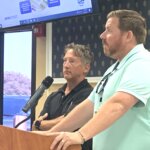
Animation
CAPE MAY — The U.S. Coast Guard Training Center (TRACEN) here is proposing to construct two, 2-megawatt wind turbines on 328-foot towers at two locations on the base to provide 66 percent to 70 percent of the base’s energy needs.
According to a nearly 300-page report prepared by Weston Solutions, the blade of each turbine would extend another 153 feet into the air, so when operating, their total effective height would be 481 feet to the tip of the extended blade from ground level.
The two wind turbines would have a rotor diameter of 305 feet, a rotor height of 328 feet, a rotor swept area of 73,108 feet, an operating wind speed of 7.8 mph and maximum power output wind speed of 44 mph. The operating rotor speed would be 12-19 r.p.m.
The 2-MW wind turbines proposed for construction would be a state-of-the-art, three-bladed, upwind, horizontal-axis model A-2000s. Electronic controls would rotate the nacelle to face into the wind and adjust the pitch of the blades to regulate rotor speed.
Coast Guard spokesperson CWO Veronica Bandrowsky said the Coast Guard strongly supports any energy initiatives that increase use of renewable energy and other conservation measures.
The project would require permits from the state Division of Fish and Wildlife, Federal Aviation Administration, Coastal Area Facilities Review Act (CAFRA) New Jersey Resources Conservation Program, state Department of Environmental Protection, state Historic Preservation Office and Cape May’s Historic Preservation Commission, she said.
Rich Ker, TRACEN energy specialist, said construction could begin in early 2011 or late 2010 with a tentative completion date of fall 2011. Initially, a half dozen possible sites were considered for the turbines at TRACEN, he said, with two sites directly on the harbor selected for construction, away from any bird habitat.
The proposal contains a lengthy assessment of the effect the turbines would have on birds. It was written by Paul Kerlinger, a nationally known avian expert, who served as director of N.J. Audubon’s Cape May Bird Observatory for seven years.
Ker said the study shows “no significant impact” on birds.
Kerlinger’s data indicates an average annual bird mortality rate of two birds per wind turbine based on 17,500 turbines in the U.S.
Given TRACEN’s location in a bird migration area, fatality numbers and species impacted are likely to be greater per turbine than those found at Eastern and Midwestern locations, he stated in the report.
The report notes wind turbine operation could be reduced in key migratory or summer breeding periods.
“Although fatality numbers and species impacted at TRACEN are likely to be greater (on a per turbine and per megawatt per year basis) than those found at Eastern and Midwestern U.S. projects that have been studied, they are still expected to occur at levels that are actually unlikely to significantly impact avian populations,” noted the report.
Kerlinger recommended that power lines from turbines be buried and tower lighting be minimal to reduce attraction for night migrating songbirds.
“The data gained from that as far as avian population will be beneficial to other communities considering projects like this,” said Cmdr. Jack Poling.
It is predicted that bats would fare worse than birds. A summary of bat mortalities at 19 wind projects in 15 states and several international sites estimated annual mortality rates per turbine from 0.1 to 63.9 bats.
The wind turbine facility at Atlantic County Utility Authority saw 31 bat kills from July 2007 to June 2008.
The report contains computer-generated photos of how the turbines would appear from the bridge entering Cape May, Poverty Beach and Buffalo Avenue. Ker said homeowners’ concerns would be addressed at a March 11 public hearing.
The report notes the height of the blade from each turbine would extend to a similar height as that of the Rescue 21 radio tower located in the southern portion of the base. Since the blades and tower would be painted white, they should blend in more with the surrounding area than if they were a darker color.
“Regarding potential on-site aesthetic impacts, the two proposed turbine locations have been selected to avoid potential ‘flickering’ impacts to occupied buildings as a result of the blades blocking the sun. Moreover, noise impacts should be minimal, as the turbines are to be located away from existing buildings.”
In addition the wind project, all furnaces and water heaters in base housing are being replaced with high efficiency, natural gas units, he said. The base’s 50-meter swimming pool will receive a cover to reduce evaporation to save water.
The Coast Guard falls under the supervision of the Department of Homeland Security, which has mandated 30 percent of energy on bases, be produced by alternative energy by 2015.
Cape May is an exceptionally good location for wind turbines, according to the report. Only one other military site received a higher score, Attu Island, in Alaska’s Aleutian Islands, said Ker.
TRACEN did not rate highly with respect to solar energy, geothermal or biomass development.
Annual electric consumption of TRACEN is about 14.3 million kilowatts. Per the Environmental Protection Agency, by the year 2013 at TRACEN, at least 7.5 percent or 1 million kilowatts should be from renewal sources.
TRACEN considered four possible scenarios for wind turbines:
• Construct three, 2 mega watt turbines, cost of $22 million.
• Construct two, 2 megawatt turbines, cost of $14 million.
• Construct three, 1-megawatt turbines, cost of $9.5 million
• Construct a single, 2-megawatt turbine, cost of $7.5 million.
NORESCO, a company with a number of federal alternative energy contracts, would construct the turbines at its own expense, without using taxpayers’ money and take payment from actual energy savings on the base, said Ker.
The Coast Guard would own the wind turbines in about 15 to 18 years, said Poling.
Ker said the project contributes to Gov. Jon Corzine’s mandate for 200kw of on shore wind by 2012.
A nearly 300-page proposal is available at Cape May City Hall, the library on or line: www.uscg.mil/hq/capemay
A hearing will be held March 11 at 7 p.m. at City Hall, 643 Washington St. where public comment will be taken.







